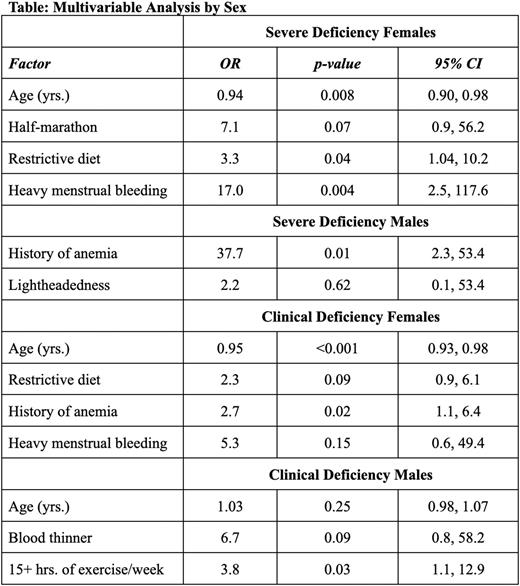Abstract
Background Iron deficiency, with or without anemia, may be more prevalent in endurance athletes than the general population. Marathon and half-marathon runners, a subset of these endurance athletes, are at risk for iron deficiency via several mechanisms, such as increased demand, foot-strike hemolysis, sweat, and others. The prevalence of iron deficiency among marathon and half-marathon runners in the United States has not been studied.
Methods
We performed a cross-sectional study to identify the prevalence of iron deficiency in runners participating in the Detroit Free Press Marathon or Half-Marathon on October 17, 2021. Eligible participants were screened at the pre-race expo, at which time they filled out questionnaires and had blood samples taken. The questionnaires included items such as demographic information, exercise and dietary habits, bleeding history, and symptoms. The blood samples were tested the same day for hemoglobin, hematocrit, ferritin, serum iron, total iron binding capacity (TIBC) and iron saturation. Participants received their laboratory results and a $30 Amazon gift card via email for participating.
For the purpose of our study, we defined severe iron deficiency as ferritin <15 ng/mL, or ferritin <35ng/mL and iron saturation <16%. This was likely consistent with absent iron storage and similar to previous definitions used in studies examining other endurance athletes. As clinicians, we agreed upon clinical iron deficiency as ferritin <30 ng/mL, or ferritin <100 ng/mL and iron saturation < 20%. This was likely consistent with low iron stores, at-risk iron stores, or iron deficiency in some populations. This definition is also likely to prompt treatment and/or investigation. Data were analyzed using chi-squared analysis, Student's t-test, ANOVA and logistic regression using SPSS v. 28.0.
Results
Of 277 participants, the mean age was 40.6 ± 13.6 years, and 38.6% (n=107) were male. Most of our participants identified as white (n=219, 79.1%). All participants were residents of the United States; 213 participants (80.1%) were from Michigan. The majority of our participants registered for the half marathon: 185 (66.8%) half marathon, 87 (31.4%) marathon, and three (1.1%) unknown.
The prevalence of clinical iron deficiency was significantly higher in females than males, 47.6% versus 15%, respectively (p<0.001). The same trend was found for severe iron deficiency, 14.7% in females vs. 2.8% in males (p=0.001). These results were independent of anemia status. On univariable analysis, factors associated with iron deficiency (clinical and/or severe) included younger age, race entered, history of anemia, heavy menstrual bleeding, blood thinner use, ≥15 hours of exercise per week, restrictive dietary habits, and lightheadedness. For multivariable analysis, we ran separate models by sex (Table).
Conclusion Iron deficiency is prevalent in marathon and half-marathon runners and is associated with several risk factors, which differ by sex. Patients who participate in endurance sports and/or training should be screened accordingly.
Disclosures
No relevant conflicts of interest to declare.
Author notes
Asterisk with author names denotes non-ASH members.


This feature is available to Subscribers Only
Sign In or Create an Account Close Modal